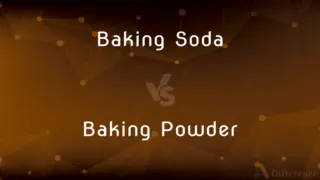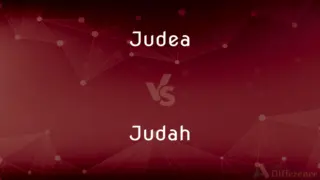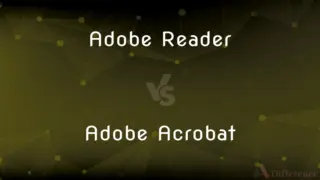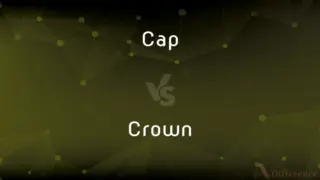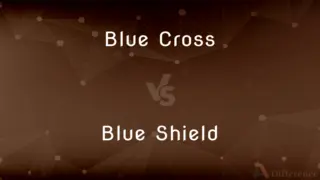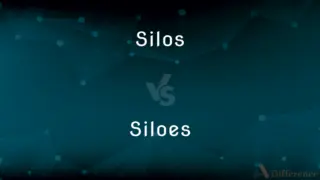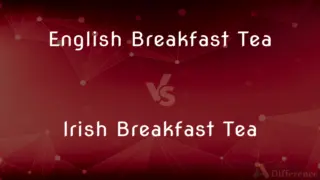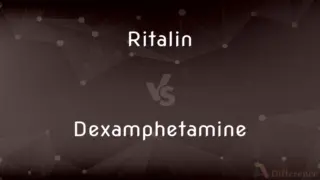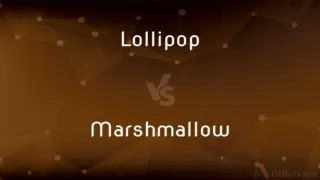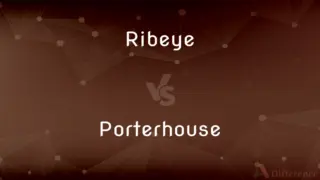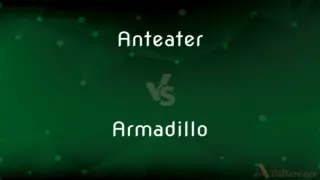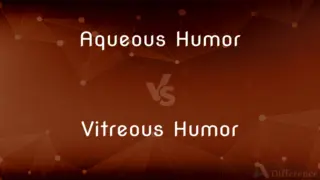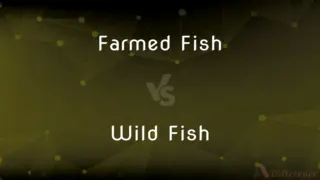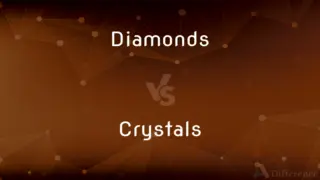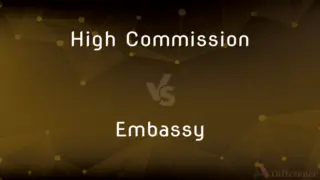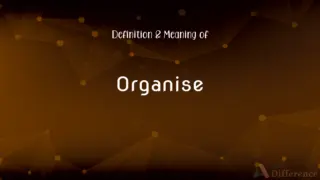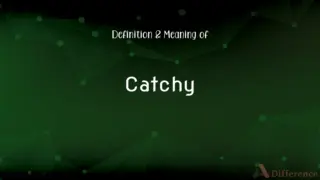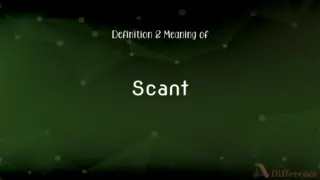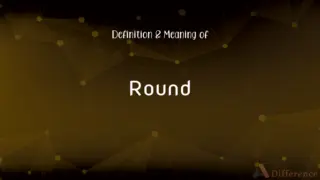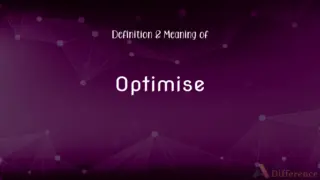Woad vs. Indigo — What's the Difference?
Edited by Tayyaba Rehman — By Urooj Arif — Updated on April 8, 2024
Woad is a plant source for blue dye historically used in Europe, while indigo, derived from various plants, has been a global dye staple with a deeper hue.

Difference Between Woad and Indigo
Table of Contents
ADVERTISEMENT
Key Differences
Woad (Isatis tinctoria) is a plant native to the steppe and desert zones of Europe and Asia, historically used in ancient and medieval Europe for producing a light blue dye. Whereas indigo, obtained from plants of the genus Indigofera, is more commonly associated with a richer and darker blue dye, popular worldwide for centuries.
Woad dye is produced by fermenting the leaves of the plant, which releases the dye precursor indican. This process results in a lighter blue compared to indigo. On the other hand, indigo dye involves a similar fermentation process but yields a significantly darker and more vibrant blue, due to higher concentrations of indigotin.
The cultivation of woad was historically important in regions like France and Britain, serving as a significant economic activity until the import of indigo from the Americas and Asia. Indigo, with its superior dye quality, gradually replaced woad in the global dye market.
Woad has also been used for medicinal purposes and as a pigment in painting, offering a range of uses beyond textile dyeing. In contrast, indigo's main appeal lies in its deep, vibrant blue dye, which has made it a staple in fabric dyeing, especially for denim jeans.
The process of dyeing with woad is more labor-intensive and time-consuming, which contributed to its decline in favor of indigo, known for its more straightforward dyeing process and more consistent results.
ADVERTISEMENT
Comparison Chart
Source
Isatis tinctoria plant
Indigofera plants
Color
Lighter blue
Deeper, more vibrant blue
Historical Use
Europe, especially ancient and medieval
Global, with significant use in Asia and Americas
Production Process
Fermentation of leaves releases indican
Similar fermentation, but yields more indigotin
Applications
Dyeing, medicinal uses, and as pigment
Primarily dyeing, especially in textiles
Compare with Definitions
Woad
A dye obtained from the woad plant.
The tapestry was dyed with woad to achieve its striking blue color.
Indigo
A deep blue dye from the Indigofera plant.
Indigo is the preferred dye for making blue jeans.
Woad
Used for medicinal and pigment purposes.
Apart from dyeing, woad has been used for treating inflammation.
Indigo
Global dyeing material with a rich history.
Indigo dye has been valued for its vibrant color in many cultures.
Woad
A plant species (Isatis tinctoria) used for blue dye.
Woad was once widely cultivated across Europe for its dye.
Indigo
A plant genus used for extracting blue dye.
Indigofera tinctoria is among the most commonly used species for indigo dye.
Woad
Historical dyeing material in Europe.
Medieval manuscripts often mention garments dyed with woad.
Indigo
The mainstay of textile dyeing industries.
The textile industry relies heavily on indigo for dyeing fabrics.
Woad
A symbol of ancient and medieval dyeing traditions.
Woad dyeing represents a link to the past.
Indigo
Represents the evolution of dyeing technologies.
The use of indigo dye symbolizes advancements in dyeing techniques.
Woad
(countable) The plant Isatis tinctoria.
Indigo
Indigo is a deep color close to the color wheel blue (a primary color in the RGB color space), as well as to some variants of ultramarine, based on the ancient dye of the same name. The word "indigo" comes from the Latin for Indian as the dye was originally exported to Europe from India.
Woad
A yellow-flowered European plant of the cabbage family. It was formerly widely grown in Britain as a source of blue dye, which was extracted from the leaves after they had been dried, powdered, and fermented.
Indigo
Any of various shrubs or herbs of the genus Indigofera in the pea family, having pinnately compound leaves and usually red or purple flowers in axillary racemes.
Woad
An annual Eurasian plant (Isatis tinctoria) in the mustard family, formerly cultivated for its leaves that yield a blue dye.
Indigo
A dark blue crystalline compound, C16H10N2O2, that is obtained from these plants or produced synthetically and is widely used as a textile dye. Also called indigotin.
Woad
The dye obtained from this plant.
Indigo
Any of several related plants, especially those of the genera Amorpha and Baptisia.
Woad
The blue dye made from the leaves of the plant.
Indigo
The hue of that portion of the visible spectrum lying between blue and violet, evoked in the human observer by radiant energy with wavelengths of approximately 420 to 450 nanometers; a dark blue to grayish purple blue.
Woad
To plant or cultivate woad.
Indigo
A purplish-blue colour
Woad
To dye with woad.
Indigo
An indigo-colored dye obtained from certain plants (the indigo plant or woad), or a similar synthetic dye.
Woad
An herbaceous cruciferous plant (Isatis tinctoria) of the family Cruciferae (syn. Brassicaceae). It was formerly cultivated for the blue coloring matter derived from its leaves. See isatin.
Indigo
An indigo plant, such as from species in genera Indigofera, Amorpha (false indigo), Baptisia (wild indigo), and Psorothamnus and Dalea (indigo bush).
Woad
A blue dyestuff, or coloring matter, consisting of the powdered and fermented leaves of the Isatis tinctoria. It is now superseded by indigo, but is somewhat used with indigo as a ferment in dyeing.
Their bodies . . . painted with woad in sundry figures.
Indigo
Having a deep purplish-blue colour
Woad
A blue dyestuff obtained from the woad plant
Indigo
A kind of deep blue, one of the seven prismatic colors.
Woad
Any of several herbs of the genus Isatis
Indigo
A blue dyestuff obtained from several plants belonging to very different genera and orders, such as, the woad, Isatis tinctoria (family Cruciferae), Indigofera suffroticosa, Indigofera tinctoria (family Leguminosae), Indigofera Anil, Nereum tinctorium, Polygonum tinctorium Ait. (family Polygonaceae), etc.; called also natural indigo. It is a dark blue earthy substance, tasteless and odorless, with a copper-violet luster when rubbed. Indigo does not exist in the plants as such, but is obtained by decomposition of the glycoside indican.
Indigo
Having the color of, pertaining to, or derived from, indigo.
Indigo
A blue dye obtained from plants or made synthetically
Indigo
Deciduous subshrub of southeastern Asia having pinnate leaves and clusters of red or purple flowers; a source of indigo dye
Indigo
A blue-violet color
Common Curiosities
Where was woad historically used?
Woad was mainly used in Europe, especially in ancient and medieval times, for dyeing textiles.
What is indigo?
Indigo is a deep blue dye extracted from several species of the Indigofera plant, used worldwide for dyeing textiles.
What is woad?
Woad is a dye obtained from the leaves of the Isatis tinctoria plant, historically used in Europe for producing blue dye.
Can woad be used for purposes other than dyeing?
Yes, woad has been used for medicinal purposes and as a pigment in addition to being a dye.
Was woad ever used in painting?
Yes, woad has been used as a pigment in painting, alongside its dyeing applications.
How does the color of woad compare to indigo?
Woad produces a lighter blue shade, while indigo yields a deeper and more vibrant blue.
Is indigo more popular than woad?
Yes, indigo is more popular and widely used than woad due to its deeper color and global availability.
How is indigo dye produced?
Indigo dye is produced through the fermentation of Indigofera plant leaves, which releases indigotin, the dye's main component.
Are there any environmental concerns with indigo dyeing?
Yes, the dyeing process for indigo can be water-intensive and potentially polluting if waste is not properly managed.
What was the economic significance of woad cultivation?
Woad cultivation was a significant economic activity in regions like France and Britain, due to the demand for blue dye.
What makes indigo preferable to woad in textile dyeing?
Indigo is preferable for its richer color, more straightforward dyeing process, and more consistent results.
What are the main differences in the production process of woad and indigo?
The main differences lie in the concentration of dye produced, with indigo yielding a higher concentration of indigotin, leading to a deeper blue color.
Can the color from woad and indigo be distinguished easily?
While both provide a blue hue, indigo’s color is typically deeper and more vibrant, making it distinguishable from woad.
Why did indigo replace woad in the dye market?
Indigo replaced woad due to its superior dye quality, richer color, and more efficient production process.
How has the use of indigo evolved over time?
The use of indigo has evolved from traditional textile dyeing to being a key ingredient in modern denim manufacturing.
Share Your Discovery

Previous Comparison
Quicksilver vs. Mercury
Next Comparison
Concentration vs. MeditationAuthor Spotlight
Written by
Urooj ArifUrooj is a skilled content writer at Ask Difference, known for her exceptional ability to simplify complex topics into engaging and informative content. With a passion for research and a flair for clear, concise writing, she consistently delivers articles that resonate with our diverse audience.
Edited by
Tayyaba RehmanTayyaba Rehman is a distinguished writer, currently serving as a primary contributor to askdifference.com. As a researcher in semantics and etymology, Tayyaba's passion for the complexity of languages and their distinctions has found a perfect home on the platform. Tayyaba delves into the intricacies of language, distinguishing between commonly confused words and phrases, thereby providing clarity for readers worldwide.




